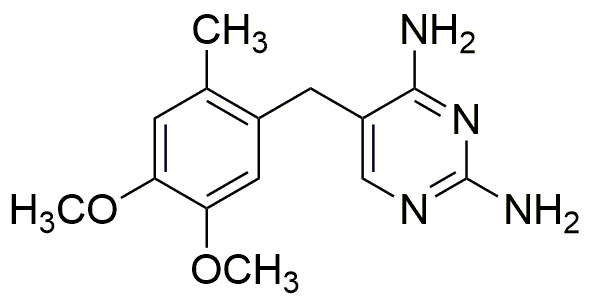Ormetoprim is widely utilized in research focused on:
- Veterinary Medicine: It is primarily used as an antimicrobial agent in livestock, particularly in poultry and swine, to prevent and treat bacterial infections, enhancing animal health and productivity.
- Pharmaceutical Development: Researchers explore its potential in developing new medications, leveraging its unique properties to create effective treatments for various infections.
- Feed Additives: In the agricultural sector, it is incorporated into animal feed to improve growth rates and feed efficiency, providing a cost-effective solution for farmers.
- Research Studies: It serves as a model compound in pharmacological studies, helping scientists understand drug interactions and resistance mechanisms in bacteria.
- Environmental Impact Assessments: Its use in veterinary applications prompts studies on its environmental effects, aiding in the development of sustainable practices in animal husbandry.
General Information
Properties
Safety and Regulations
Applications
Ormetoprim is widely utilized in research focused on:
- Veterinary Medicine: It is primarily used as an antimicrobial agent in livestock, particularly in poultry and swine, to prevent and treat bacterial infections, enhancing animal health and productivity.
- Pharmaceutical Development: Researchers explore its potential in developing new medications, leveraging its unique properties to create effective treatments for various infections.
- Feed Additives: In the agricultural sector, it is incorporated into animal feed to improve growth rates and feed efficiency, providing a cost-effective solution for farmers.
- Research Studies: It serves as a model compound in pharmacological studies, helping scientists understand drug interactions and resistance mechanisms in bacteria.
- Environmental Impact Assessments: Its use in veterinary applications prompts studies on its environmental effects, aiding in the development of sustainable practices in animal husbandry.
Documents
Safety Data Sheets (SDS)
The SDS provides comprehensive safety information on handling, storage, and disposal of the product.
Product Specification (PS)
The PS provides a comprehensive breakdown of the product’s properties, including chemical composition, physical state, purity, and storage requirements. It also details acceptable quality ranges and the product's intended applications.
Certificates of Analysis (COA)
Search for Certificates of Analysis (COA) by entering the products Lot Number. Lot and Batch Numbers can be found on a product’s label following the words ‘Lot’ or ‘Batch’.
*Catalog Number
*Lot Number
Certificates Of Origin (COO)
This COO confirms the country where the product was manufactured, and also details the materials and components used in it and whether it is derived from natural, synthetic, or other specific sources. This certificate may be required for customs, trade, and regulatory compliance.
*Catalog Number
*Lot Number
Safety Data Sheets (SDS)
The SDS provides comprehensive safety information on handling, storage, and disposal of the product.
DownloadProduct Specification (PS)
The PS provides a comprehensive breakdown of the product’s properties, including chemical composition, physical state, purity, and storage requirements. It also details acceptable quality ranges and the product's intended applications.
DownloadCertificates of Analysis (COA)
Search for Certificates of Analysis (COA) by entering the products Lot Number. Lot and Batch Numbers can be found on a product’s label following the words ‘Lot’ or ‘Batch’.
*Catalog Number
*Lot Number
Certificates Of Origin (COO)
This COO confirms the country where the product was manufactured, and also details the materials and components used in it and whether it is derived from natural, synthetic, or other specific sources. This certificate may be required for customs, trade, and regulatory compliance.


